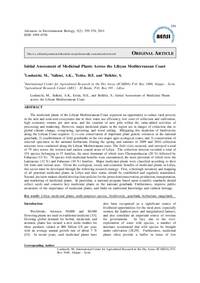Initial Assessment of Medicinal Plants Across the Libyan Mediterranean Coast

Authors:
The medicinal plants of the Libyan Mediterranean Coast represent an opportunity to reduce rural poverty in the arid and semi-arid ecosystems due to their water use efficiency, low costs of collection and cultivation, high economic returns per unit area, and the creation of new jobs within the value-added activities of processing and marketing. However, major medicinal plants in the region are in danger of extinction due to global climate change, overgrazing, uprooting, and wood cutting. Mitigating this depletion of biodiversity along the Libyan Coast requires: 1) ex-situ conservation of important plant genetic resources in the national genebank; 2) establishment of field genebanks in the two major agro-ecological zones; and 3) conservation of selected specimen in the national herbarium. During the spring and summer of 2009 and 2010 collection missions were conducted along the Libyan Mediterranean coast. The field visits occurred, and surveyed a total of 79 sites across the western and eastern coastal areas of Libya. The collection mission recorded a total of 151 species belonging to 47 families, the most dominant of which were Chenopodiaceae (20 %) followed by Fabaceae (13 %). 78 species with medicinal benefits were encountered, the most prevalent of which were the Lamiaceae (12 %) and Fabaceae (10 %) families. Major medicinal plants were classified according to their life form and various uses. Given the ecological, social, and economic benefits of medicinal plants in Libya, this sector must be developed through the following research strategy. First, a thorough inventory and mapping of all potential medicinal plants in Libya and their status should be established and regularly maintained. Second, decision-makers should develop clear policies for the protection/conservation, production, transportation, and marketing of medicinal plants. In particular, a national program based upon scientific standards should collect seeds and conserve key medicinal plants in the national genebank. Furthermore, improve public awareness of the importance of medicinal plants, and build on traditional knowledge and cultural heritage.
